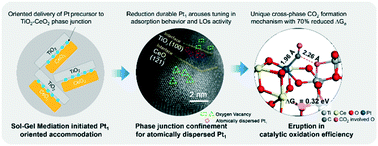Phase junction-confined single-atom TiO2–Pt1–CeO2 for multiplying catalytic oxidation efficiency†
Abstract
Single-atom catalysts (SACs) are advocated for theoretical 100% atom efficiency and high reactivity. Further breakthroughs in catalytic efficiency beyond the present SACs will rely on upgrading the intrinsic activity of each active site via sophisticated catalyst design, which is undoubtedly challenging. Herein, we report the use of the phase junction confinement principle to construct a TiO2–Pt1–CeO2 ensemble with unprecedented reactivity. The reduction-durable TiO2–Pt1–CeO2 unit enabled weakened CO affinity and extensive lattice oxygen activation, which subsequently led to facilitated O2 activation. Additionally, the TiO2–Pt1–CeO2 interface structure initiated a unique cross-phase oxidation mechanism. The balanced adsorption behaviour, enhanced surface lattice oxygen reactivity, and substantially lowered reaction barrier enabled such a catalyst to realize a great increase in CO oxidation efficiency (300 K) with multiplied specific mass reactivity compared to the impregnated analogue and the pilot Pt1/FeOx catalyst. This work demonstrates a plausible synthesis philosophy and reaction mechanism for SACs that will create a new frontier in reactivity.



 Please wait while we load your content...
Please wait while we load your content...